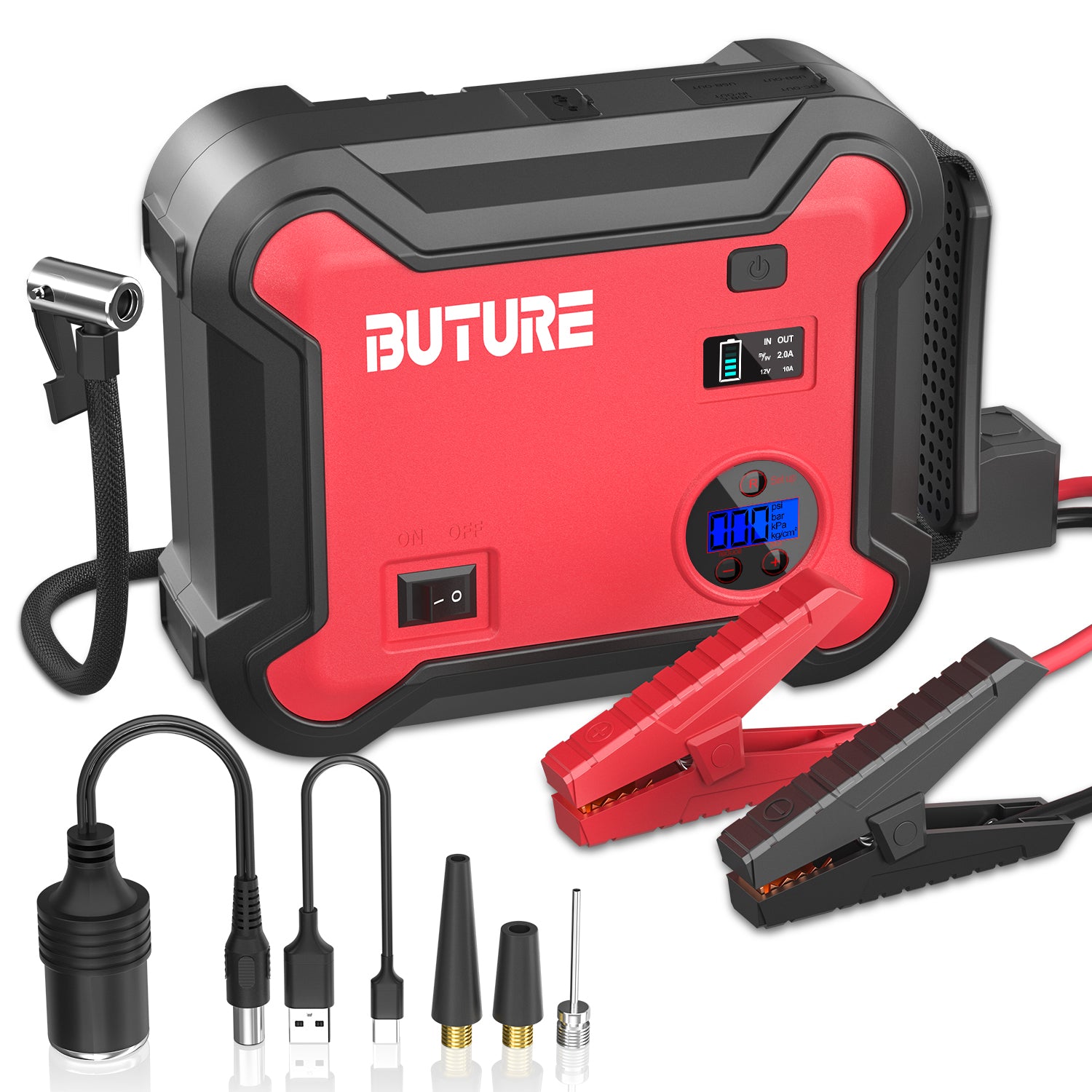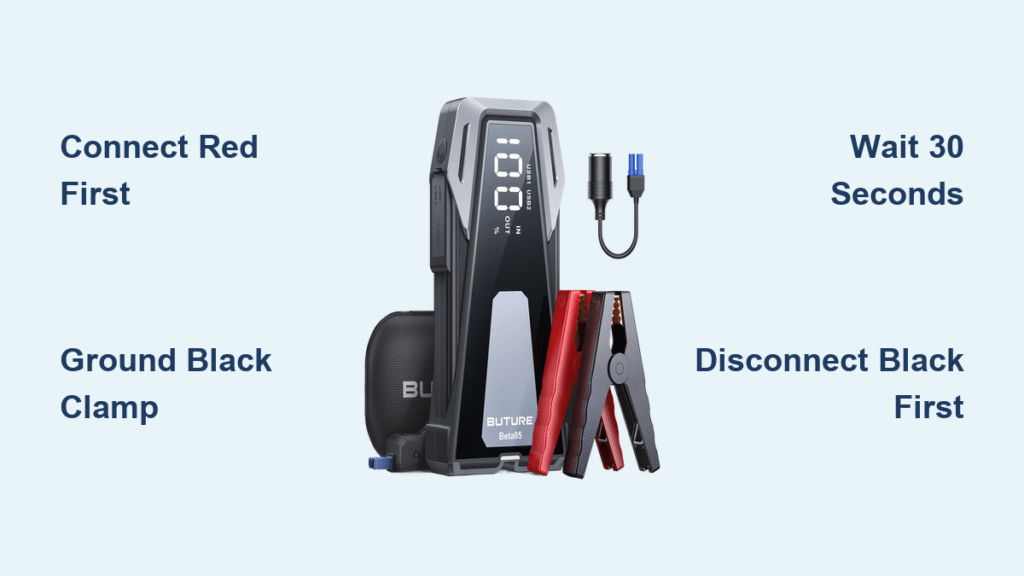Your car battery dies on a freezing morning—the dashboard lights barely glow, and the engine only clicks. Instead of waiting hours for roadside assistance, you can revive your vehicle in minutes with a Buture jump starter. These palm-sized powerhouses deliver enough amps to restart dead batteries without another car. Knowing how to use Buture jump starter properly transforms you from stranded to self-sufficient in any emergency.
Forget wrestling with traditional jumper cables. Modern Buture models pack smart safety features and multi-function capabilities into a portable unit. This guide delivers step-by-step instructions verified through manufacturer specifications—so you’ll never second-guess the process again. By the end, you’ll confidently handle dead batteries while avoiding dangerous mistakes.
Critical Pre-Jump Safety Measures
Park and Prepare Your Vehicle Correctly
Shift into park (automatic) or neutral with parking brake engaged on level ground. Move away from traffic lanes into well-lit areas like parking lots. Completely disable all electrical drains: turn off headlights, radio, climate control, and phone chargers. Remove metal jewelry like rings or bracelets—these can cause catastrophic sparks if they contact battery terminals during connection.
Inspect Battery for Damage Before Proceeding
Examine your car battery for cracks, fluid leaks, or excessive corrosion (white/green crust). If you spot physical damage or swelling, do not attempt a jump start—call for professional assistance. Verify your Buture model supports standard 12V automotive systems (all current Buture units do). Confirm compatibility with your engine type: diesel requires 1000+ peak amps, while hybrids need special jump points per your vehicle manual.
Confirm Buture Power Status
Press the power button once to activate the LED display. You need at least 50% charge shown for reliable starting—red indicators or single-bar displays mean insufficient power. If low, plug into the wall charger for 30 minutes minimum. Extreme cold reduces lithium battery efficiency; warm the unit in your coat pocket for 5 minutes if temperatures are below freezing.
Locate and Identify Every Component

Essential Parts on Your Buture Unit
Your jump starter contains three mission-critical elements: the main power box (with digital display showing 0-100% charge), smart jumper cables with integrated safety module, and color-coded clamps. The red clamp always connects to positive (+) battery terminals (marked with red covers or “+” symbols). The black clamp attaches to unpainted metal chassis points—never directly to the negative battery terminal to prevent explosive hydrogen gas ignition.
Decode Safety Feature Indicators
The smart cable’s safety module uses color-coded lights to prevent disasters: solid green means secure connection, while flashing red/green indicates reverse polarity. This built-in protection automatically cuts power if clamps touch metal accidentally. All Buture models include spark-proof technology that eliminates dangerous arcs during connection—critical for safely reviving sulfated or frozen batteries.
Execute Jump Start in Four Phases
Phase 1: Device Activation Sequence
Press the power button for 2-3 seconds until the display illuminates. If your battery is completely dead (0V), activate BOOST mode by pressing the dedicated button—this delivers maximum cranking amps. Fully extend jumper cables to avoid overheating from coiled wires. Never drape cables over the engine; lay them straight along the fender.
Phase 2: Perfect Clamp Connection Technique
Connect red first to the positive battery terminal, ensuring metal-to-metal contact (scrape corrosion with a key if needed). Connect black second to an unpainted engine bolt or bracket at least 18 inches from the battery—ideal spots include alternator mounts or suspension brackets. Wait 5 seconds for the safety module to confirm solid green lights. If lights flash red/green, immediately disconnect and swap clamp positions.
Phase 3: Engine Cranking Protocol
After green lights confirm, wait 30 seconds for the Buture to analyze battery health. Turn the ignition key for 3-5 seconds maximum—any longer overheats the starter motor. If the engine doesn’t catch, wait 2 full minutes before retrying to allow the jump starter to cool. Once running, let the engine idle for 3 minutes to stabilize voltage before driving.
Phase 4: Safe Disconnection Order
Remove black clamp first from the chassis ground point. Remove red clamp second from the positive terminal. Press the power button to shut down the Buture—never yank cables while active. Coil cables loosely without sharp bends (kinks damage internal wires) and store in the included carrying case.
Fix Common Jump Starter Failures

When Buture Won’t Power On
If the display stays dark, the unit may be in deep-sleep mode. Hold the power button for 10+ seconds to reset. Still unresponsive? Charge for 1 full hour—lithium batteries appear dead below -4°F but recover when warmed. Avoid using in temperatures above 140°F; let the device cool in shade for 15 minutes first.
Interpret Warning Lights Correctly
- Red/green flashing: Reverse polarity—swap red/black clamp positions
- Solid red light: Battery voltage below 8V—use BOOST mode or seek replacement
- Continuous beeping: Short circuit—inspect clamps for frayed wires or metal contact
- No green light: Poor grounding—reposition black clamp to bare metal chassis
Solutions When Engine Still Won’t Crank
Try a different grounding point—rust or paint prevents conductivity. For diesel engines, confirm your Buture delivers 1000+ peak amps (check model specs). After three failed attempts, the battery likely has shorted cells. Replace it rather than risking jump starter damage.
Maximize Device Longevity

Monthly Maintenance Checklist
Check charge levels every 30 days—recharge if below 60%. Clean corroded clamps with a wire brush, then apply dielectric grease (sold at auto stores) to prevent future buildup. Test jump capability quarterly on a healthy battery to verify peak amp delivery. After 500+ uses, expect 10-15% capacity loss; dim LED indicators signal replacement time.
Climate-Controlled Storage Rules
Never leave your Buture in glove compartments during summer (interiors exceed 160°F) or winter (lithium freezes below -4°F). Store in climate-controlled spaces at 60-80% charge—fully depleted units degrade faster. Use the carrying case with silica gel packets in humid areas to prevent moisture damage.
Unlock Advanced Capabilities
Emergency Power Bank Functions
Your Buture charges devices via dual USB ports: a 20000mAh model powers an iPhone 12 four times or a MacBook via USB-C PD. Activate BOOST mode for faster phone charging during emergencies. Never use power bank functions while jump starting—this overloads the circuitry.
Multi-Mode LED Flashlight Usage
Press the flashlight button once for steady light during tire changes, twice for emergency strobe (visible 1+ mile away), three times for SOS signals. The 20-hour runtime outlasts most roadside assistance waits—ideal for signaling help at night.
Jump Starting Multiple Vehicles
One full charge handles 20-40 starts for 4-cylinder engines. Always allow 2-minute cooling breaks between jumps to prevent thermal shutdown. For diesel trucks, verify 1500+ peak amp capacity—attempting jumps beyond specs permanently damages the unit.
Non-Negotiable Safety Reminders
Never jump start in active rain or snow—dry terminals thoroughly first. For hybrids, locate manufacturer-specified jump points away from high-voltage orange cables. Always connect clamps to the dead battery before powering on the Buture. If you smell sulfur (rotten eggs) or see battery swelling, abandon the jump and call professionals—these indicate imminent battery explosion risk.
Mastering how to use Buture jump starter transforms roadside panic into confidence. Keep your unit charged to 80%, store it properly, and perform quarterly tests—this ensures reliable starts through blizzards, heatwaves, or dead-of-night emergencies. Register your purchase within 30 days for the full 24-month warranty, and you’ll never pay for tow trucks again. Your next dead battery? Just another 90-second victory.





